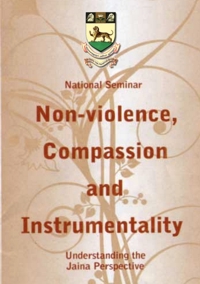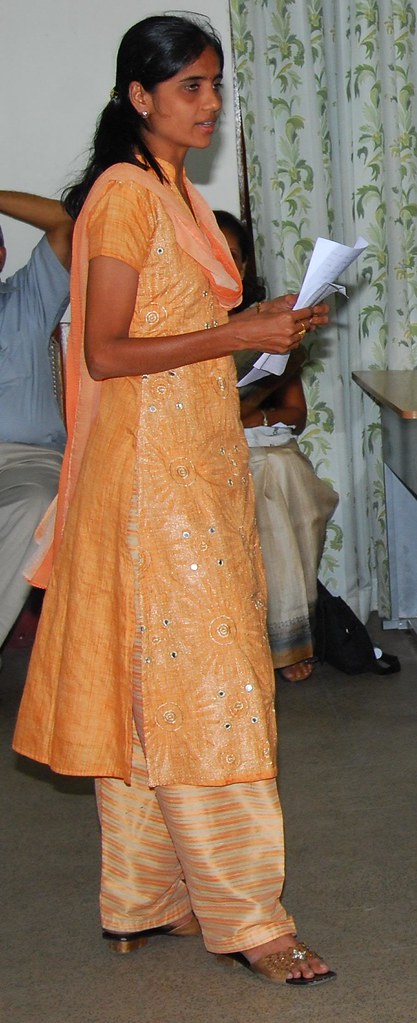Chennai 2009: Non-violence, Compassion and Instrumentality - A Jaina Perspective
 | Non-violence, Compassion and InstrumentalityA Jaina PerspectiveSeminar organized by the Department of Jainology of the University of Madras, 13 and 14 February 2009 Chennai, India |
Non-violence: Its Dimensions and Practices
13.2.2009
Dreaded by fear, frustration and war, humanity today is at crossroads. The present world can be called an age of restlessness and conflicts. Every country in the world and individuals are suffering in one form or another. Every country or individual is trying to find a way out of these difficulties in their own way viz., by development plans, arms and ammunitions, nuclear arms, more developments of science and technology etc., as it is believed that by these means mankind would be safeguarded against want and misery and these efforts would pave the way for peace and prosperity. Can these means give us the solution? In my opinion certainly not. The solution lies in the cult of non-violence and other relevant doctrines which can enable us to realize the much desired peace and real progress. It is only the observance of non-violence, which can save the human race. It is mutual credibility and the belief in the equality of human beings which can restore peace and harmony in human society. Lord Mahāvīra has seen this truth many centuries ago. In the Ācāraṅga Sūtra he proclaimed that there are number of weapons superior to each other, but nothing is superior to non-violence.
Non-violence - the foundation of every religionMeaning of non-violence:Ahiṁsā (non-violence) in its truest sense does not only mean not to injure others but also embraces the universal law of love and compassion for all which is an indispensable feature for the existence of family, society, nation and the entire existence. It is a mere principle of a particular religion. It is in consonance with the true nature of all living beings.
No religion has ever preached hiṁsā, i.e. violence. The basic aim of each religion is to promote fellowship, co-operation, happiness and mutual understanding in the society which can never be achieved by treading the path of hiṁsā.
Lord Mahāvīra was convinced that not only mankind but all the living being, moving and static should not be harmed because each one of them just like the human beings, does not want any harm to be done to it. He preached to the people his conviction in these words:
Save panel piyana, sahasaya dukkhapadikala appiyavaha Piyajivino jiviukama savvesimjiviyam piyam
All beings like to live, desire pleasure, hate pain, shun destruction and love to live. To all life is dear.
Emphasizing this conviction, the Ācāraṅga Sūtra declares
All the worthy men of the past, the present and the future say thus, speak thus, declare thus, explain thus, that all the breathing, existing, living and sentient creature should not be slave, nor treated with violence, nor abused nor tormented nor driven away.
This is the pure, eternal and unchangeable law or the tenet of religion.
Bhaktapraijñā also mentions the superiority of non-violence over all other virtues. It says "just as in the world there is nothing higher than mountain Meru and nothing extended than the sky, so also (in the world) there is nothing excellent and universal that the virtue of non-violence is considered as a shelter to all the living beings. In it Ahiṁsā is equated with sixty virtuous qualities such as peace, harmony, welfare, trust, fearlessness etc. Ācārya Amṛtacandra in his famous work Puruṣārthasiddhupaya maintains that "all moral practices such as truthfulness etc. are included in Ahiṁsā. Similarly all the vices are comprehended in hiṁsā because virtues do not vitiate the real nature of self while vices do vitiate. Thus, in Jainism non-violence represents all the virtues and violence all the vices.
The same view is also propounded in the famous Hindu work Mahābhārata. It says 'As the foot-prints of all smaller animals are encompassed in the foot-print of an elephant in the same way all the virtues (dharmas) are included in Ahiṁsā. Further it maintains that there is nothing higher than the virtue of non-violence because it comprehends all the virtues. Lord Buddha in Dhammapada also remarks enmity is never appeased by enmity, but only by non-enmity - this is an eternal law. In other words it is not violence, but non-violence that can be accepted as a universal law of human conduct. And today we can see for ourselves the impact of not respecting this law in the form of challenges like Global Warming, Environmental Degradation, etc.
Not only in indigenous religions, but in the Semitic religions also non-violence is accepted as religious virtues. "Thou shall not kill" is one of the Ten Commandments. In the Holy Bible Jesus Christ also said "Love thy enemy." In Islam the Supreme being (Allah) is called the Beneficent (Al-Rahman) and the merciful (Al-Raheem). These injunctions of the great prophets and lawgivers of the world show that it is the doctrine of non-violence which can only be a universal law of an advanced human society.
Non-violence - A Positive ConceptThe term non-violence has various connotations. Generally it means not to kill, slain or hurt any living being. Ahiṁsā means abstention or refraining from hiṁsā. One must not intentionally injure the feelings or the life forces of any living being, either by thought, word or deed himself, through an agent or even by approving of such an act committed by someone else. hiṁsā refers to any action accompanied by the giving of pain or the rise of passions.
The Jains believe that non-violence in the Supreme religion - "ahiṁsā paromo dharmaḥ". It postulates reverence for life and avoidance of injury. It means kindness and compassion. It means environmental protection and prevention of cruelty to animals, birds and insects. Lord Mahāvīra threw new light on the perennial quest of the soul with the truth and discipline of ahiṁsā. He said:
There is nothing as small and subtle as the atom, not any element as vast as space. Similarly there is no quality of soul more subtle than non-violence and no virtue of spirit greater than reverence for life.
In the Tattvārtha Sūtra, Umāsvatiī defines violence as "pramattayogat pranavyaparopanam hiṁsā" that is "the destruction of life due to an act involving negligence is violence." To destroy or injure through negligence or ill will, to hurt the feelings of others, to insult others - to ensure others to speak all of others behind their back, to cause fear or to wound their feelings in violence.
In Jainism violence is considered of two types - dravyahiṁsā and bhavahiṁsā. The act of harming or hurting is dravyahiṁsā i.e. external violence and the intention to hurt or to kill is bhavahiṁsā i.e. internal violence. We commit violence in thought before we commit it in action. Violence in thought or psychic violence is the true violence. The Daśavaikalika Sūtra states that no sin accrues to one who walks, stands, sits, sleep, eats and speaks with vigilance. It is said that a negligent ascetic is violent with regard to all living beings, but if the ascetic behaves vigilantly and remains unattached just as a lotus in water, then the ascetic is not considered to be violent, even though some violence may occur unwillingly.
It would here be well to stress that hiṁsā is not something negative, i.e. not to kill; but it has positive meaning also as compassion and service to living beings. To establish unity with all living beings, without any kind of distinction. It is love that sustains the earth. Life without love is death. And Ahiṁsā is nothing but love to all even for the meanest. Ahiṁsā teaches that we have to behave with others as we would like to be treated by others and this is the essence of Lord Mahāvīra’s teachings -
"Jam ichhasi appanto, jam cana ichhari appanato tarn iccha parassa vi, ettiyagam jinasasanayam".
The whole human race is one and if we have to consider the world as a family, the idea of Ahiṁsā should be taught to everybody. In Daśavaikalika Sūtra 4/9 it is told that
Savve bhuyappabhnyarasa samain bhuyaim pasao Thitriyasayassa dantassa pavakammam na bandhai
I have friendship with all the living beings. To have neither revenge nor enmity with anybody - this is the ideal motto of the doctrines of ahiṁsā. Ahiṁsā is also the key to world peace and friendship. It is a bridge to cross the ocean of sufferings. It could convert a foe into a friend and effect mutual understanding and reconciliation between two opposing parties and person.
Ahiṁsā in practical life is nothing but the exercise of forgiveness, friendliness, tolerance, self-control, fearlessness etc. and to practice Ahiṁsā with determination in tackling the problems of life the various forms of hiṁsā like anger, lust, vanity, avarice etc. are to be given up.
Ācārya Svayambhava suri states in Daśavaikalika sutra:
Uvasmena hano koham manam madhyavava jine Mayamajjava bhvenam loham santosaojine
Conquer your anger not by anger, but by forgiveness, conquer your pride not by pride but by politeness or modesty. Conquer your hypocrisy not by hypocrisy, but by mode of modesty. Conquer your greed not by greed but by own satisfaction.
 Dr. M. Nirmala
Dr. M. Nirmala
